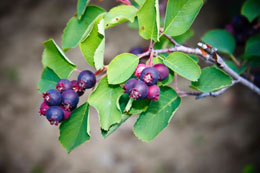The juneberry tree is native to various parts of North America. This write-up provides some interesting facts about this tree.

The juneberry tree belongs to the genus
Amelanchier and
Rosaceae family. The genus comprises about 20 species of small deciduous trees, shrubs, and bushes. This multi-stemmed tree can be seen in all the states of the US with the exception of Hawaii. The fruits of some of the varieties ripen in the month of June, hence the name. This deciduous tree is called by many names that include saskatoon, shadbush, shadblow, sugarplum, wild plum, chuckley pear, and serviceberry tree. The scientific name of this tree is
Amelanchier canadensis. The species that are categorized under this genus could grow to a height ranging from three to twenty six feet.
Facts
- Not only is this tree good to look at, the fruits that are produced by this tree are delicious. The purple-colored berries produced by this tree are used for making delicious pies, jams, and jellies.
- Its beautiful five-petaled white flowers grow in masses. The bloom season starts in the spring.
- The star-shaped flowers are produced in racemes. Each of the racemes comprises four to ten flowers.
- While you might love the beautiful drooping clusters of flowers, it is the beautiful foliage that makes this tree so popular. The new foliage is coppery pink in color. As it matures, it turns into a dark green.
- With autumn around the corner, you can see the foliage turning to a rich red. The color of the foliage changes into a vibrant orange during autumn.
- Due to its vibrant-colored foliage, this tree is rated as one of the best ornamental trees for landscaping. It can surely add visual interest to any place.
- During the summer season, you can spot red-colored berries on the tree. Their color changes to purple in autumn. The bark of this tree is also ornamental. One of the species that is known to produce delicious berries is Amelanchier alnifolia.
- If you have this tree in your garden, make sure that you protect the berries from birds. Though you might enjoy watching birds such as cardinals, robins, and mocking birds flitting around the tree, if you wish to use the berries for culinary purposes, make sure that you keep these birds away. Otherwise, the birds would eat the berries, even before they ripen.
- Autumn Brilliance, Prince William, and Princess Diana are some of the popular varieties.
- The superior quality fruiting cultivars include Northline, Pembina, Honeywood, and Smokey Juneberry.
- This small tree is perfect for cottage garden style planting.
- While this tree is used for landscaping for obvious reasons, you can also keep it as a bonsai.
Caring for this Tree
- For the proper growth of this tree, make sure that the soil is well-drained. A neutral-acidic soil will definitely work well. Ideally, the soil pH should lie in the range of 5.5 to 7.5. Make sure that the soil is not chalky.
- Though this ornamental tree grows well in full sun, it will survive in partial shade as well.
- You must water it well initially. Once the tree has been established, it can survive in harsh and dry conditions as well.
- If you want to grow a small-sized tree, you could train it to be so by pruning. This way, you can encourage the growth of multiple trunks.
- Cedar apple rust, powdery mildew, leaf blight, and fire blight are some of the diseases that could affect this tree. Make sure that you take steps to prevent an infestation of trunk borers, scales, or aphids.
- If the leaves seem to be wilting or you notice any fungal growth on the foliage or fruit, remove the diseased part. If the bark seems to be withering, you must remove the affected bark immediately.
Juneberry figures on the top in the list of ornamental trees. Not only will this tree add color to your garden, you can also use the berries for culinary purposes.






 The juneberry tree belongs to the genus Amelanchier and Rosaceae family. The genus comprises about 20 species of small deciduous trees, shrubs, and bushes. This multi-stemmed tree can be seen in all the states of the US with the exception of Hawaii. The fruits of some of the varieties ripen in the month of June, hence the name. This deciduous tree is called by many names that include saskatoon, shadbush, shadblow, sugarplum, wild plum, chuckley pear, and serviceberry tree. The scientific name of this tree is Amelanchier canadensis. The species that are categorized under this genus could grow to a height ranging from three to twenty six feet.
The juneberry tree belongs to the genus Amelanchier and Rosaceae family. The genus comprises about 20 species of small deciduous trees, shrubs, and bushes. This multi-stemmed tree can be seen in all the states of the US with the exception of Hawaii. The fruits of some of the varieties ripen in the month of June, hence the name. This deciduous tree is called by many names that include saskatoon, shadbush, shadblow, sugarplum, wild plum, chuckley pear, and serviceberry tree. The scientific name of this tree is Amelanchier canadensis. The species that are categorized under this genus could grow to a height ranging from three to twenty six feet.